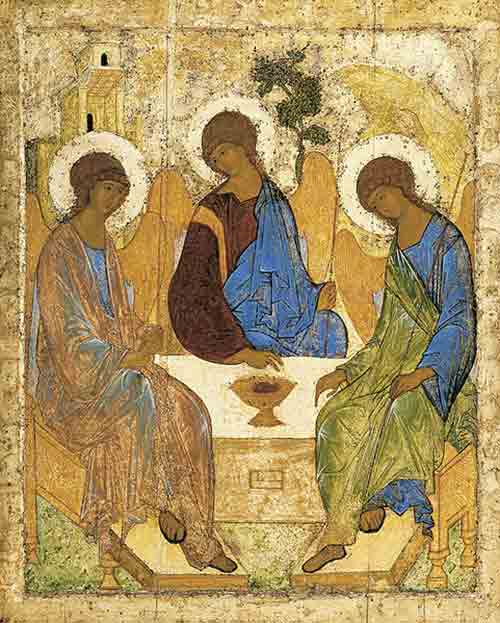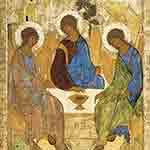
This week is the tenth week in Ordinary Time (Counting Time). On Sunday, June 16, Trinity Sunday takes precedence and hence replaces the Sunday in the eleventh week in Ordinary Time.
Let us pray (in silence) [to God the source of all being, through the eternal Word, in the power of the Holy Spirit]
pause
Almighty and everlasting God,
you have given to us your servants grace,
by the confession of a true faith,
to acknowledge the glory of the eternal Trinity,
and in the power of your divine Majesty to worship the Unity,
may we, through the steadfastness of this faith,
evermore be defended from all adversities;
through Jesus Christ
who is alive with you,
in the unity of the Holy Spirit,
one God, now and for ever.
Amen.
The above is my reworking for my Book of Prayers in Common in which I seek to provide a set of collects with history and commentary.
Trinity Sunday is a Feast Day, hence this collect is not used during the week following – the collect on weekdays, this year for next week, is that for Ordinary Week 11.
Trinity Sunday is notorious for, through attempted explanations of the Trinity, oversimplifying the doctrine to the point of affirming exactly what the doctrine is not trying to convey. Sermons regularly erroneously stray into tritheism/polytheism (that there are three gods); modalism (that there are three forms of God – like steam, liquid, and ice); and Subordinationalism (God the Father is the greatest. Coming in second is God the Son, followed by the second runner-up, the Holy Spirit).
Click on the following link to read my commentary and reflection on Trinity Sunday and its collect: Trinity Sunday.
The following may be another useful quote:
A world of one dimension would be a straight line. In a two-dimensional word, you still get straight lines, but many lines make one figure. In a three-dimensional world, you still get figures but many figures make one solid body. In other words, as you advance to more real and more complicated levels, you do not leave behind you the things you found on the simpler levels: you still have them, but combined in new ways–in ways you could not imagine if you knew only the simpler levels.
Now the Christian account of God involves just the same principle. The human level is a simple and rather empty level. On the human level one person is one being, and any two persons are two separate beings- just as in two dimensions (say on a flat sheet of paper) one square is one figure, and two squares are two separate figures. On the Divine level you still find personalities; but up there you find them combined in new ways which we, who do not live on that level, cannot imagine. In God’s dimension, so to speak, you find a being who is three Persons while remaining one Being, just as a cube is six squares while remaining one cube. [Mere Christianity, C.S. Lewis p. 137-138]
On the top of this page is Rublev’s icon of the Trinity reflection 1 reflection 2
In the New Zealand Anglican Church there is no requirement to use a creed at a Eucharist. My suggestion is that Trinity Sunday be one Sunday when the Niceno-Constantinopolitan Creed be said by all. Just to stir things along a bit, it might be said as per the original, ie, omitting the Filioque (“and the Son” – added at the non-ecumenical 3rd Council of Toledo, 589). Some provinces have restored the original. Others of us in communities that use the Filioque might find ourselves suddenly pausing for a breath at that point and so find ourselves proclaiming: “… who proceeds from the Father <sudden need to draw breath> with the Father and the Son…” Who knows, a majority in a community, may suddenly all find themselves needing to draw breath at this point…
Lambeth Conference 1978 passed “that all member Churches of the Anglican Communion should consider omitting the Filioque from the Nicene Creed, and that the Anglican-Orthodox Joint Doctrinal Commission through the Anglican Consultative Council should assist them in presenting the theological issues to their appropriate synodical bodies and should be responsible for any necessary consultation with other Churches of the Western tradition.”
Lambeth Conference 1988 passed “that further thought be given to the Filioque clause, recognising it to be a major point of disagreement (with the Orthodox) … recommending to the provinces of the Anglican Communion that in future liturgical revisions the Niceno-Constantinopolitan Creed be printed without the Filioque clause.”
The General Convention of The Episcopal Church (USA) in 1985 recommended that the Filoque clause should be removed from the Nicene Creed, if this were endorsed by the 1988 Lambeth Conference. This has not been implemented. The Anglican Church of Canada conforms to the Lambeth resolution.

Some relate Trinity Sunday to the Athanasian Creed. This is not the most popular of creeds nowadays. From a liturgical perspective, it may be worth highlighting “the Catholic Faith is this: That we worship” – this is the universal Christian faith: worship. On Trinity Sunday, of course, it is worth continuing: “the Catholic Faith is this: That we worship one God in Trinity, and Trinity in Unity”. Some other parts of the Athanasian Creed may be harder work to explain (not that explaining the Trinity will be particularly an easy task…).
The Church of England has used the Athanasian Creed as a source for:
We proclaim the Church’s faith in Jesus Christ.
Creeds and Authorized Affirmations of Faith – E7
All We believe and declare that our Lord Jesus Christ,
the Son of God, is both divine and human.
God, of the being of the Father,
the only Son from before time began;
human from the being of his mother, born in the world;
All fully God and fully human;
human in both mind and body.
As God he is equal to the Father,
as human he is less than the Father.
All Although he is both divine and human
he is not two beings but one Christ.
One, not by turning God into flesh,
but by taking humanity into God;
All truly one, not by mixing humanity with Godhead,
but by being one person.
For as mind and body form one human being
so the one Christ is both divine and human.
All The Word became flesh and lived among us;
we have seen his glory,
the glory of the only Son from the Father,
full of grace and truth.
I am not, however, suggesting that this replace the Niceno-Constantinopolitan Symbol/Creed, nor do I think it is helpful to have a second credal declaration in one service. One creed and a solid Eucharistic Prayer (our Christian Shema) I think is quite sufficient.
Resources for Preaching from Downunder
Textweek Resources for Trinity Sunday
In with the comments, please also remember to feel free to add links and suggestions for hymns, prayers, etc. for Trinity Sunday.
If you appreciated this post, consider liking the liturgy facebook page, using the RSS feed, and/or signing up for a not-very-often email, … if you are on Instagram, please follow @liturgy.




Here’s a new (2012) hymn I wrote for Trinity Sunday, since published by the UK Methodist Church.
http://www.singingthefaithplus.org.uk/?p=15684
Thanks so much, David. Blessings.
The Trinity in three words https://michaelroberts4004.wordpress.com/2015/05/31/the-doctrine-of-the-trinity-in-three-words-and-ten-letters/
Thanks, Michael. Blessings.